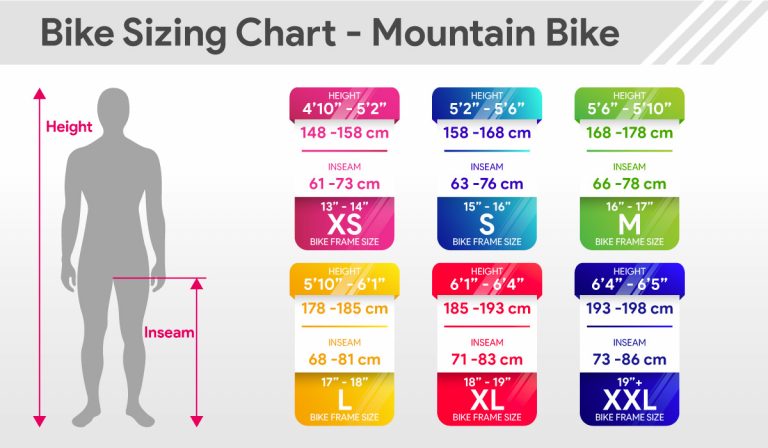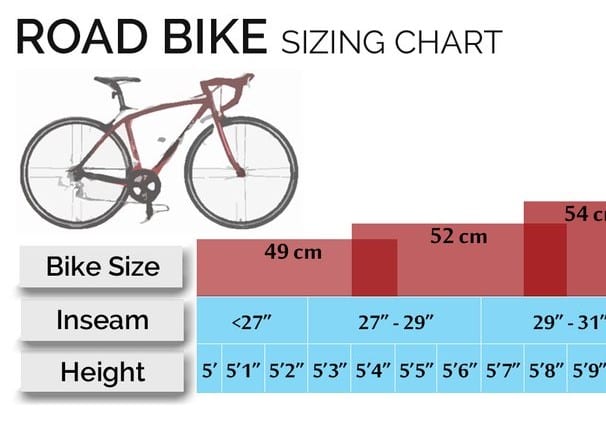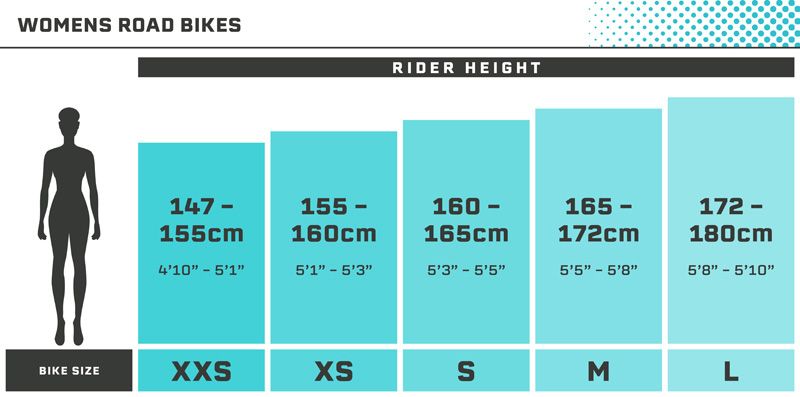Understanding the Basics of Road Bike Sizing
Choosing the right road bike size for women is crucial for ensuring a comfortable, safe, and enjoyable riding experience. A road bike size chart for women is an essential tool that helps determine the correct bike size based on various body measurements. By selecting the appropriate bike size, women can optimize their performance, reduce the risk of injury, and enhance overall satisfaction with their cycling experience.
Relevance of Women’s Specific Road Bike Geometry
Women’s specific road bikes are designed with unique geometry to accommodate the anatomical differences between men and women. These bikes typically feature a shorter top tube, a more upright riding position, and narrower handlebars, which contribute to a more comfortable and efficient riding experience for women.
Popular brands such as Liv, Specialized, and Trek offer women’s specific road bikes with tailored geometry. For instance, Liv’s Langma and Specialized’s Amira models are designed with a women’s-specific endurance geometry, providing a comfortable and efficient riding position for long distances. Trek’s Domane and Madone series also offer women’s-specific models with optimized frame geometry and components for a better fit and enhanced performance.
How to Measure Yourself for a Road Bike
To ensure a proper fit when selecting a road bike, it’s essential to measure your body accurately. Follow this step-by-step guide to gather the necessary measurements:
- Height: Stand against a wall and measure from the ground to the top of your head using a measuring tape or a level tool. Record your height in centimeters or inches.
- Inseam: Measure the length of your inseam by standing with your back against a wall and placing a book between your legs, simulating the position of a bike saddle. Measure from the ground to the top edge of the book. Record the measurement in centimeters or inches.
- Arm length: With your arms extended, measure the distance from the center of the back of your neck to the tip of your middle finger. Record the measurement in centimeters or inches.
These measurements will help you determine the appropriate road bike size and frame geometry for your body type. A road bike size chart for women, like the one presented in the following section, will assist in selecting the correct bike size based on your height and inseam measurements.
Women’s Road Bike Size Chart: Breaking Down the Sizes
A road bike size chart for women is an essential tool for determining the correct bike size based on height and frame measurements. The following chart breaks down the bike sizes according to height, providing a general guideline for selecting the appropriate frame size:
| Height Range (cm/in) | Frame Size (cm/in) |
|---|---|
| 150-155 cm / 4’11” – 5’1″ | 44-48 cm / 17-19 in |
| 155-160 cm / 5’1″ – 5’3″ | 48-51 cm / 19-20 in |
| 160-165 cm / 5’3″ – 5’5″ | 51-54 cm / 20-21 in |
| 165-170 cm / 5’5″ – 5’7″ | 54-56 cm / 21-22 in |
| 170-175 cm / 5’7″ – 5’9″ | 56-58 cm / 22-23 in |
| 175-180 cm / 5’9″ – 5’11” | 58-60 cm / 23-24 in |
| 180-185 cm / 5’11” – 6’1″ | 60-62 cm / 24-25 in |
Please note that this chart serves as a general guideline, and individual body proportions may require slight adjustments. Fine-tuning your bike fit, as discussed in the following section, is crucial for optimal comfort and performance.

Refer to this visual representation of the women’s road bike size chart for a quick and easy reference when selecting your new road bike.
Fine-Tuning Your Road Bike Fit
Once you have selected a road bike that closely matches your size using a women’s road bike size chart, it’s essential to fine-tune the bike fit for optimal comfort and performance. Proper bike fit ensures efficient power transfer, minimizes strain on your body, and reduces the risk of injury. Consider the following adjustments:
Saddle height
The saddle height significantly impacts your pedaling efficiency and comfort. To adjust the saddle height, follow these steps:
- Stand next to your bike and place your heel on the pedal. The pedal should be at the bottom of its stroke.
- Your leg should be almost straight, with a slight bend at the knee.
- Adjust the saddle height accordingly, ensuring a 25-35 degree bend in your knee when your foot is at the ball of the pedal.
Saddle position
The fore and aft position of the saddle affects your weight distribution and comfort. To adjust the saddle position, follow these steps:
- Sit on your bike and place your pedals in a horizontal position.
- Locate the point where your knee is directly above the pedal axle.
- Draw a vertical line from this point to the center of the bottom bracket.
- Adjust the saddle position so that the line intersects the middle of the pedal axle.
Handlebar reach
Handlebar reach affects your comfort and control of the bike. To adjust the handlebar reach, follow these steps:
- Sit on your bike and ensure your arms are slightly bent at the elbows.
- Check that your back is in a comfortable, neutral position.
- If necessary, adjust the handlebar height and stem length to achieve the ideal reach.
By fine-tuning your road bike fit, you can significantly improve your comfort, performance, and overall riding experience. Remember to consult a professional bike fitter for personalized advice and adjustments.
Selecting the Right Women’s Road Bike: Factors to Consider
When choosing a women’s road bike, it’s essential to consider several factors to ensure a perfect match for your riding style, experience level, and budget. Here are some key aspects to keep in mind:
Riding style
Identify your primary riding style, such as recreational riding, long-distance touring, or competitive racing. Different styles may require specific features or components, so selecting a bike tailored to your needs is crucial.
Experience level
Consider your experience level when selecting a road bike. Beginners may prefer a more forgiving and versatile bike, while experienced riders might opt for a more performance-oriented model. Keep in mind that some high-performance bikes may be less comfortable for long rides or newcomers.
Budget
Establish a budget for your new road bike, taking into account the cost of the bike itself, as well as any additional accessories or upgrades you may need. Remember that more expensive bikes often come with better components and construction, but there are also many high-quality, affordable options available.
Popular brands and models
Some popular women’s road bike brands and models include:
- Specialized Amira
- Trek Émonda
- Giant TCR Advanced
- Cannondale SuperSix EVO
- Liv Langma
These bikes are known for their women’s-specific geometry, high-quality components, and excellent performance. However, it’s essential to consider your personal preferences and needs when selecting a bike.
By taking the time to evaluate your riding style, experience level, and budget, you can make an informed decision and choose a women’s road bike that meets your needs and provides a comfortable, enjoyable riding experience.
Common Mistakes to Avoid When Choosing a Women’s Road Bike
When selecting a women’s road bike, it’s crucial to be aware of common pitfalls that can negatively impact your riding experience. Here are some common mistakes to avoid and tips on how to make a better-informed decision:
Focusing solely on frame size
While frame size is essential, it’s only one aspect of the bike fit. Consider other factors such as saddle height, saddle position, and handlebar reach to ensure a comfortable and efficient riding position.
Ignoring riding style
Failing to consider your riding style can lead to an unsuitable bike. For example, a racing bike may not be ideal for long-distance touring, and a recreational bike might not provide the performance needed for competitive racing. Make sure to choose a bike that aligns with your primary riding style.
Neglecting to test ride
Without test riding a bike, it’s challenging to determine if it’s the right fit for you. Whenever possible, test ride a bike before purchasing to ensure it meets your expectations and provides a comfortable riding experience.
Overlooking adjustability
Bikes with limited adjustability can make it difficult to fine-tune the fit. Look for bikes with adjustable components, such as saddle height and handlebar reach, to ensure a customizable fit that suits your body and riding style.
Prioritizing aesthetics over functionality
While a visually appealing bike can be enticing, it’s essential to prioritize functionality and comfort. Don’t let aesthetic factors overshadow the bike’s performance, fit, and suitability for your riding style.
By being mindful of these common mistakes and taking the time to consider your individual needs, you can make a more informed decision when choosing a women’s road bike. Remember to consult a detailed women’s road bike size chart, like the one provided in the previous section, and seek professional advice if needed to ensure the best possible fit and riding experience.




